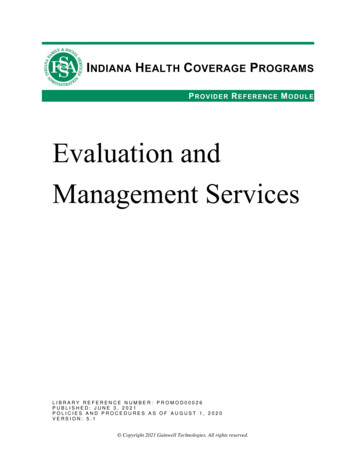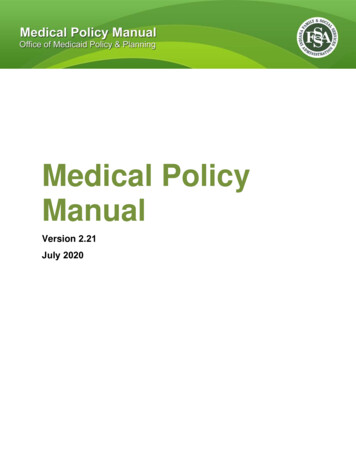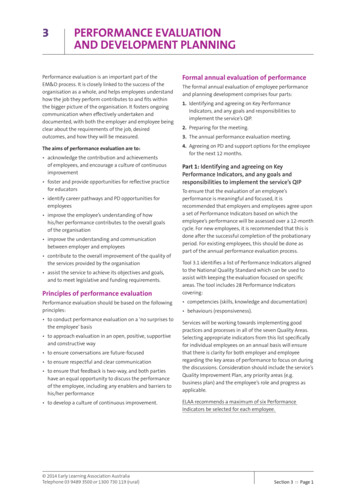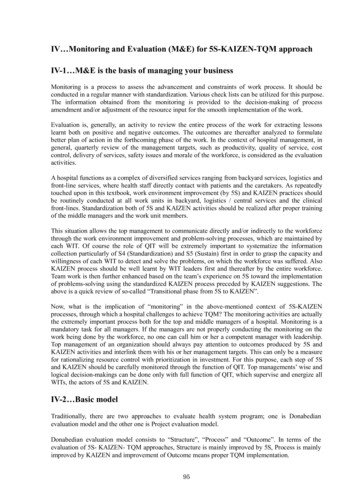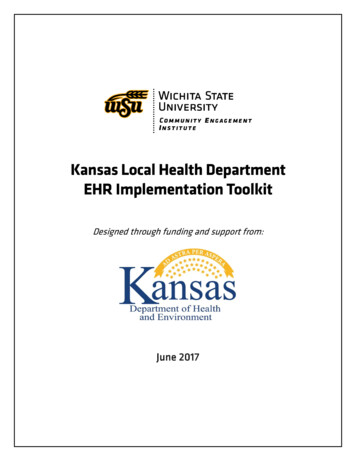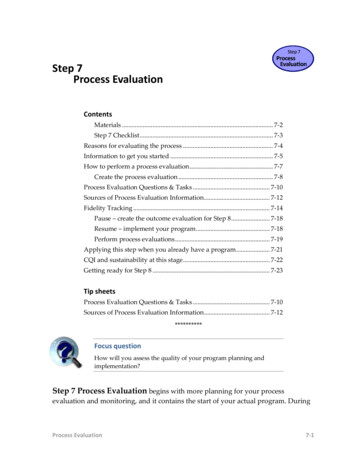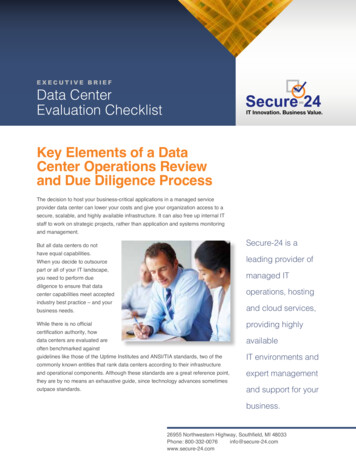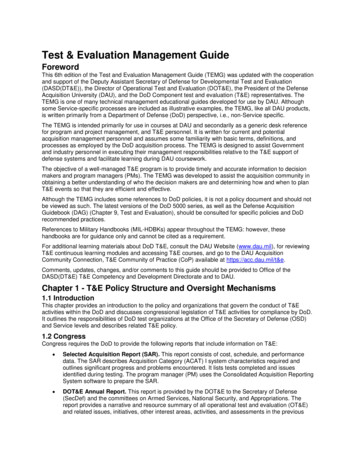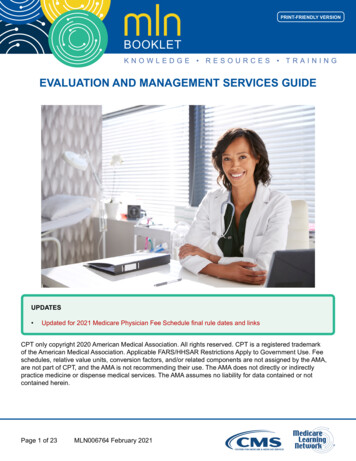
Transcription
PRINT-FRIENDLY VERSIONBOOKLETEVALUATION AND MANAGEMENT SERVICES GUIDEUPDATES Updated for 2021 Medicare Physician Fee Schedule final rule dates and linksCPT only copyright 2020 American Medical Association. All rights reserved. CPT is a registered trademarkof the American Medical Association. Applicable FARS/HHSAR Restrictions Apply to Government Use. Feeschedules, relative value units, conversion factors, and/or related components are not assigned by the AMA,are not part of CPT, and the AMA is not recommending their use. The AMA does not directly or indirectlypractice medicine or dispense medical services. The AMA assumes no liability for data contained or notcontained herein.Page 1 of 23MLN006764 February 2021
Evaluation and Management Services GuideMLN BookletTABLE OF CONTENTSPREFACE3MEDICAL RECORD DOCUMENTATION4GENERAL PRINCIPLES OF E/M DOCUMENTATION4COMMON SETS OF CODES USED TO BILL FOR E/M SERVICES5HCPCSInternational Classification of Diseases, 10th Revision, Clinical Modification/ProcedureCoding System (ICD-10-CM/PCS)56E/M SERVICES PROVIDERS6SELECTING THE CODE THAT BEST REPRESENTS THE SERVICE FURNISHED6Patient TypeSetting of ServiceLevel of E/M Service PerformedHistoryElements Required for Each Type of HistoryChief Complaint (CC)History of Present Illness (HPI)Review of Systems (ROS)Past, Family, and/or Social History (PFSH)ExaminationGeneral Multi-System ExaminationSingle Organ System ExaminationMedical Decision MakingElements for Each Level of Medical Decision MakingNumber of Diagnoses and/or Management OptionsAmount and/or Complexity of Data to Be ReviewedRisk of Significant Complications, Morbidity, and/or MortalityTable of RiskDocumentation of an Encounter Dominated by Counseling and/or Coordination of Care667777891012131415151516171820OTHER CONSIDERATIONS21Split/Shared ServicesConsultation Services2121RESOURCES22E/M Services ResourcesHYPERLINK TABLEPage 2 of 23MLN006764 February 20212223
Evaluation and Management Services GuideMLN BookletINTRODUCTIONThis guide is intended to educate providers about the general principles of evaluation and management (E/M)documentation, common sets of codes used to bill for E/M services, and E/M services providersThis guide is offered as a reference tool and does not replace content found in the 1995 DocumentationGuidelines for Evaluation and Management Services and the 1997 Documentation Guidelines for Evaluationand Management Services. These publications are also available in the Reference Section.NOTE: For billing Medicare, you may use either version of the documentation guidelines for a patientencounter, not a combination of the two.For reporting services furnished on and after September 10, 2013, to Medicare, you may use the 1997documentation guidelines for an extended history of present illness along with other elements from the1995 documentation guidelines to document an evaluation and management service.Page 3 of 23MLN006764 February 2021
Evaluation and Management Services GuideMLN BookletGENERAL PRINCIPLES OF E/M DOCUMENTATIONClear and concise medical record documentation is critical to providing patients with quality care and isrequired for you to receive accurate and timely payment for furnished services. Medical records chronologicallyreport the care a patient received and record pertinent facts, findings, and observations about the patient’shealth history. Medical record documentation helps physicians and other health care professionals evaluateand plan the patient’s immediate treatment and monitor the patient’s health care over time.Health care payers may require reasonable documentation to ensure that a service is consistent with thepatient’s insurance coverage and to validate: The site of service The medical necessity and appropriateness of the diagnostic and/or therapeutic services provided That services furnished were accurately reportedGeneral principles of medical record documentation apply to all types of medical and surgical services in allsettings. While E/M services vary in several ways, such as the nature and amount of physician work required,these general principles help ensure that medical record documentation for all E/M services is appropriate: The medical record should be complete and legible The documentation of each patient encounter should include: Reason for the encounter and relevant history, physical examination findings, and prior diagnostictest results Assessment, clinical impression, or diagnosis Medical plan of care If date and legible identity of the observer if the rationale for ordering diagnostic and other ancillaryservices is not documented, it should be easily inferred Past and present diagnoses should be accessible to the treating and/or consulting physician Appropriate health risk factors should be identified The patient’s progress, response to and changes in treatment, and revision of diagnosis shouldbe documented The diagnosis and treatment codes reported on the health insurance claim form or billing statementshould be supported by documentation in the medical recordTo maintain an accurate medical record, document services during the encounter or as soon as practicableafter the encounter.Page 4 of 23MLN006764 February 2021
Evaluation and Management Services GuideCOMMON SETS OF CODES USED TOBILL FOR E/M SERVICESWhen billing for a patient’s visit, select codes thatbest represent the services furnished during thevisit. A billing specialist or alternate source mayreview the provider’s documented services beforesubmitting the claim to a payer. These reviewers helpselect codes that best reflect the provider’s furnishedservices. However, the provider must ensure that thesubmitted claim accurately reflects theservices provided.The provider must also ensure that medical recorddocumentation supports the level of service reportedto a payer. You should not use the volume ofdocumentation to determine which specific level ofservice to bill.Services must meet specific medical necessityrequirements in the statute, regulations, and manualsand specific medical necessity criteria definedby National Coverage Determinations and LocalCoverage Determinations (if any exist for the servicereported on the claim). For every service billed, youmust indicate the specific sign, symptom, or patientcomplaint that makes the service reasonableand necessary.HCPCSThe HCPCS is the Health Insurance Portability andAccountability Act-compliant code set for providersto report procedures, services, drugs, and devicesfurnished by physicians and other non-physicianpractitioners, hospital outpatient facilities, ambulatorysurgical centers, and other outpatient facilities. Thissystem includes Current Procedural TerminologyCodes, which the American Medical Associationdeveloped and maintains.MLN BookletEffective January 1, 2021 CMS is aligning E/Mcoding with changes adopted by the AmericanMedical Association (AMA) Current ProceduralTerminology (CPT) Editorial Panel for office/outpatient E/M visits, which: Retains 5 levels of coding for establishedpatients, reduces the number of levels to4 for office/outpatient E/M visits for newpatients, and revises the code definitions Revises the times and medical decisionmaking process for all of the codes, andrequires performance of history and examonly as medically appropriate Allows clinicians to choose the E/M visitlevel based on either medical decisionmaking or timeFor more information, review the CY 2021Physician Fee Schedule Web Page andthe Medicare Learning Network (MLN)Connects Physician Fee Schedule Final Rule:Understanding 4 Key Topics Call transcript,recording and presentation.Effective January 1, 2021, CMS isconsolidating and increasing payment forthe Medicare-specific add-on code, HCPCScode GPC1X, for office/outpatient E/M visitsfor primary care and non-procedural specialtycare into a single code describing the workassociated with visits that are part of ongoing,comprehensive primary care and/or visits thatare part of ongoing care related to a patient’ssingle, serious, or complex chronic condition.This code is not intended to reflect a differencein payment by enrollment specialty, but rathera better recognition of differences betweenkinds of visits.Page 5 of 23MLN006764 February 2021
Evaluation and Management Services GuideMLN BookletInternational Classification of Diseases, 10th Revision, Clinical Modification/Procedure CodingSystem (ICD-10-CM/PCS)ICD-10-CM codes – A code set providers use to report medical diagnoses on all types of claims for servicesfurnished in the United States (U.S.).ICD-10-PCS codes – A code set facilities use to report inpatient procedures and services furnished in U.S.hospital inpatient health care settings. Use HCPCS codes to report ambulatory services and physicianservices, including those physician services furnished during an inpatient hospitalization.E/M SERVICES PROVIDERSTo receive payment from Medicare for E/M services, the Medicare benefit for the relevant type of provider mustpermit him or her to bill for E/M services. The services must also be within the scope of practice for the relevanttype of provider in the State in which they are furnished.SELECTING THE CODE THAT BEST REPRESENTS THE SERVICE FURNISHEDBilling Medicare for an E/M service requires the selection of a Current Procedural Terminology (CPT) code thatbest represents: Patient type Setting of service Level of E/M service performedPatient TypeFor purposes of billing for E/M services, patients are identified as either new or established, depending onprevious encounters with the provider.New Patient: An individual who did not receive any professional services from the physician/non-physicianpractitioner (NPP) or another physician of the same specialty who belongs to the same group practice withinthe previous 3 years.Established Patient: An individual who receives professional services from the physician/NPP or anotherphysician of the same specialty who belongs to the same group practice within the previous 3 years.Setting of ServiceE/M services are categorized into different settings depending on where the service is furnished. Examples ofsettings include: Office or other outpatient setting Hospital inpatient Emergency department (ED) Nursing facility (NF)Page 6 of 23MLN006764 February 2021
Evaluation and Management Services GuideMLN BookletLevel of E/M Service PerformedThe code sets to bill for E/M services are organized into various categories and levels. In general, the morecomplex the visit, the higher the level of code you may bill within the appropriate category. To bill any code, theservices furnished must meet the definition of the code. You must ensure that the codes selected reflect theservices furnished.The three key components when selecting the appropriate level of E/M services provided are history,examination, and medical decision making. Visits that consist predominately of counseling and/or coordinationof care are an exception to this rule. For these visits, time is the key or controlling factor to qualify for aparticular level of E/M services.HistoryThe Elements Required for Each Type of History table shows the elements required for each type of history.You can find more information on the activities comprising each of these elements on pages 7 and 8. To qualifyfor a given type of history, all four elements indicated in the row must be met. Note that as the type of historybecomes more intensive, the elements required to perform that type of history also increase in intensity.For example, a problem focused history requires documentation of the chief complaint (CC) and a brief historyof present illness (HPI), while a detailed history requires the documentation of a CC, an extended HPI, plus anextended review of systems (ROS), and pertinent past, family, and/or social history (PFSH).Elements Required for Each Type of HistoryTYPE OF HISTORYProblem FocusedExpanded uiredBriefN/AN/ARequiredBriefProblem Pertinent ePertinentCompleteTable 1: Elements for Each Type of HistoryWhile documentation of the CC is required for all levels, the extent of information gathered for the remainingelements related to a patient’s history depends on clinical judgment and the nature of the presenting problem.Chief Complaint (CC)A CC is a concise statement that describes the symptom, problem, condition, diagnosis, or reason for thepatient encounter. The CC is usually stated in the patient’s own words. For example, patient complains of upsetstomach, aching joints, and fatigue. The medical record should clearly reflect the CC.Page 7 of 23MLN006764 February 2021
Evaluation and Management Services GuideMLN BookletHistory of Present Illness (HPI)HPI is a chronological description of the developmentof the patient’s present illness from the first sign and/or symptom or from the previous encounter to thepresent. HPI elements are: Location (example: left leg) Quality (example: aching, burning,radiating pain) Severity (example: 10 on a scale of 1 to 10) Duration (example: started 3 days ago) Timing (example: constant or comes and goes) Context (example: lifted large object at work)Effective January 1, 2021, practitioners willhave the choice to document office/outpatientE/M visits via medical decision making (MDM)or time. CMS is adopting the CPT’s revisedguidance, including deletion of CPT code99201. CMS has also finalized separatepayment rates for the remaining nineE/M codes.For more information, review the CY 2021Physician Fee Schedule Final Rule, page 301and the CPT Evaluation and Managementwebpage. Modifying factors (example: better when heatis applied) Associated signs and symptoms (example:numbness in toes)The two types of HPIs are brief and extended.1. A brief HPI includes documentation of one to three HPI elements. In this example, three HPI elements –location, quality, and duration – are documented: CC: Patient complains of earache Brief HPI: Dull ache in left ear over the past 24 hours2. An extended HPI: 1995 documentation guidelines – Should describe four or more elements of the present HPI orassociated comorbidities 1997 documentation guidelines – Should describe at least four elements of the present HPI or thestatus of at least three chronic or inactive conditionsFor reporting services furnished on and after September 10, 2013, to Medicare, you may use the 1997documentation guidelines for an extended HPI along with other elements from the 1995 documentationguidelines to document an E/M service.In this example, five HPI elements – location, quality, duration, context, and modifying factors –are documented: CC: Patient complains of earache. Extended HPI: Patient complains of dull ache in left ear over the past 24 hours. Patient states he wentswimming 2 days ago. Symptoms somewhat relieved by warm compress and ibuprofen.Page 8 of 23MLN006764 February 2021
Evaluation and Management Services GuideMLN BookletReview of Systems (ROS)ROS is an inventory of body systems obtained by asking a series of questions to identify signs and/orsymptoms the patient may be experiencing or has experienced. These systems are recognized forROS purposes: Constitutional Symptoms (for example, fever, weight loss) Eyes Ears, nose, mouth, throat Cardiovascular Respiratory Gastrointestinal Genitourinary Musculoskeletal Integumentary (skin and/or breast) Neurological Psychiatric Endocrine Hematologic/lymphatic Allergic/immunologicThe three types of ROS are problem pertinent, extended, and complete.1. A problem pertinent ROS inquires about the system directly related to the problem identified in the HPI.In this example, one system – the ear – is reviewed: CC: Earache. ROS: Positive for left ear pain. Denies dizziness, tinnitus, fullness, or headache.2. An extended ROS inquires about the system directly related to the problem(s) identified in the HPI and alimited number (two to nine) of additional systems.In this example, two systems – cardiovascular and respiratory – are reviewed: CC: Follow-up visit in office after cardiac catheterization. Patient states “I feel great.” ROS: Patient states he feels great and denies chest pain, syncope, palpitations, and shortness ofbreath. Relates occasional unilateral, asymptomatic edema of left leg.Page 9 of 23MLN006764 February 2021
Evaluation and Management Services GuideMLN Booklet3. A complete ROS inquires about the system(s) directly related to the problem(s) identified in the HPIplus all additional (minimum of ten) organ systems. You must individually document those systemswith positive or pertinent negative responses. For the remaining systems, a notation indicating all othersystems are negative is permissible. In the absence of such a notation, you must individually document atleast ten systems.In this example, ten signs and symptoms are reviewed: CC: Patient complains of “fainting spell.” ROS: Constitutional: Weight stable, fatigue. Eyes: loss of peripheral vision. Ear, nose, mouth, throat: No complaints. Cardiovascular: palpitations; denies chest pain; denies calf pain, pressure, or edema. Respiratory: shortness of breath on exertion. Gastrointestinal: Appetite good, denies heartburn and indigestion. episodes of nausea. Bowelmovement daily; denies constipation or loose stools. Urinary: Denies incontinence, frequency, urgency, nocturia, pain, or discomfort. Skin: clammy, moist skin. Neurological: fainting; denies numbness, tingling, and tremors. Psychiatric: Denies memory loss or depression. Mood pleasant.Past, Family, and/or Social History (PFSH)PFSH consists of a review of three areas:1. Past history includes experiences with illnesses, operations, injuries, and treatments2. Family history includes a review of medical events, diseases, and hereditary conditions that may placethe patient at risk3. Social history includes an age appropriate review of past and current activitiesThe two types of PFSH are pertinent and complete.A pertinent PFSH is a review of the history areas directly related to the problem(s) identified in the HPI. Thepertinent PFSH must document at least one item from any of the three history areas.In this example, the patient’s past surgical history is reviewed as it relates to the identified HPI: HPI: Coronary artery disease. PFSH: Patient returns to office for follow-up of coronary artery bypass graft in 1992. Recent cardiaccatheterization demonstrates 50 percent occlusion of vein graft to obtuse marginal artery.Page 10 of 23MLN006764 February 2021
Evaluation and Management Services GuideMLN BookletA complete PFSH is a review of two or all three of the areas, depending on the category of E/M service.A complete PFSH requires a review of all three history areas for services that, by their nature, include acomprehensive assessment or reassessment of the patient. A review of two history areas is sufficient forother services.You must document at least one specific item from two of the three history areas for a complete PFSH forthese categories of E/M services: Office or other outpatient services, established patient ED Domiciliary care, established patient Subsequent NF care (if following the 1995 documentation guidelines) Home care, established patientYou must document at least one specific item from each of the history areas for these categories ofE/M services: Office or other outpatient services, new patient Hospital observation services Hospital inpatient services, initial care Consultations Comprehensive NF assessments Domiciliary care, new patient Home care, new patientIn this example, the patient’s genetic history is reviewed as it relates to the current HPI: HPI: Coronary artery disease PFSH: Family history reveals: Maternal grandparents – Both for coronary artery disease; grandfather: deceased at age 69;grandmother: still living Paternal grandparents – Grandmother: diabetes, hypertension; grandfather: heart attack atage 55 Parents – Mother: obesity, diabetes; father: heart attack at age 51, deceased at age 57 ofheart attack Siblings – Sister: diabetes, obesity, hypertension, age 39; brother: heart attack at age 45, livingNotes on the Documentation of History and Exam To simplify documentation of history and exam for established patients for office/outpatient visits, whenrelevant information is already contained in the medical record, practitioners may choose to focus theirdocumentation on what has changed since the last visit, or on pertinent items that have not changed, andneed not re-record the defined list of required elements if there is evidence that the practitioner reviewedthe previous information and updated it as needed.Page 11 of 23MLN006764 February 2021
Evaluation and Management Services GuideMLN BookletAny part of the chief complaint or history that is recorded in the medical record by ancillary staff or thebeneficiary does not need to be re-documented by the billing practitioner, and may instead review theinformation, update or supplement it as necessary, and indicate in the medical record that he or she hasdone so.(see FAQ posted isit-FAQs-PFS.pdf You may list the CC, ROS, and PFSH as separate elements of history or you may include them in thedescription of the HPI. You do not need to re-record a ROS and/or a PFSH obtained during an earlier encounter if there isevidence that the physician reviewed and updated the previous information. This may occur when aphysician updates his or her own record or in an institutional setting or group practice where manyphysicians use a common record. You may document the review and update by: Describing any new ROS and/or PFSH information or noting there is no change in the information. Noting the date and location of the earlier ROS and/or PFSH. Ancillary staff may record the HPI, ROS and/or PFSH. Alternatively, the patient may complete a form toprovide the ROS and/or PFSH. You must provide a notation supplementing or confirming the informationrecorded by others to document that the physician reviewed the information. If the physician is unable to obtain a history from the patient or other source, the record should describethe patient’s condition or other circumstance which precludes obtaining a history.ExaminationThe most substantial differences in the 1995 and 1997 versions of the documentation guidelines occur in theexamination documentation section. For billing Medicare, you may use either version of the documentationguidelines for a patient encounter, not a combination of the two. For reporting services furnished on and afterSeptember 10, 2013, to Medicare, you may use the 1997 documentation guidelines for an extended HPI alongwith other elements from the 1995 documentation guidelines to document an E/M service.The levels of E/M services are based on four types of examination:1. Problem Focused – A limited examination of the affected body area or organ system2. Expanded Problem Focused – A limited examination of the affected body area or organ system and anyother symptomatic or related body area(s) or organ system(s)3. Detailed – An extended examination of the affected body area(s) or organ system(s) and any othersymptomatic or related body area(s) or organ system(s)4. Comprehensive – A general multi-system examination or complete examination of a single organ system(and other symptomatic or related body area(s) or organ system(s) – 1997 documentation guidelines)An examination may involve several organ systems or a single organ system. The type and extent of theexamination performed is based on clinical judgment, the patient’s history, and nature of thepresenting problem(s).Page 12 of 23MLN006764 February 2021
Evaluation and Management Services GuideMLN BookletThe 1997 documentation guidelines describe two types of comprehensive examinations that can be performedduring a patient’s visit: general multi-system examination and single organ examination.A general multi-system examination involves the examination of one or more organ systems or body areas.General Multi-System ExaminationTYPE OF EXAMINATIONProblem FocusedExpanded Problem FocusedDetailedComprehensiveDESCRIPTIONInclude performance and documentation of one tofive elements identified by a bullet in one or moreorgan system(s) or body area(s).Include performance and documentation of at leastsix elements identified by a bullet in one or moreorgan system(s) or body area(s).Include at least six organ systems or body areas.For each system/area selected, performance anddocumentation of at least two elements identifiedby a bullet is expected. Alternatively, may includeperformance and documentation of at least twelveelements identified by a bullet in two or more organsystems or body areas.Include at least nine organ systems or body areas.For each system/area selected, all elements ofthe examination identified by a bullet should beperformed, unless specific directions limit thecontent of the examination. For each area/system,documentation of at least two elements identified bybullet is expected.*Table 2: General Multi-System Examination* The 1995 documentation guidelines state that the medical record for a general multi-system examinationshould include findings about eight or more organ systems.A single organ system examination involves a more extensive examination of a specific organ system.Page 13 of 23MLN006764 February 2021
Evaluation and Management Services GuideMLN BookletSingle Organ System ExaminationTYPE OF EXAMINATIONProblem FocusedExpanded Problem FocusedDetailedDESCRIPTIONInclude performance and documentation of one tofive elements identified by a bullet, whether in a boxwith a shaded or unshaded border.Include performance and documentation of at leastsix elements identified by a bullet, whether in a boxwith a shaded or unshaded border.Examinations other than the eye and psychiatricexaminations should include performance anddocumentation of at least twelve elements identifiedby a bullet, whether in a box with a shaded orunshaded border.Eye and psychiatric examinations include theperformance and documentation of at least nineelements identified by a bullet, whether in a box witha shaded or unshaded border.Include performance of all elements identified by abullet, whether in a shaded or unshaded box.ComprehensiveDocumentation of every element in each box with ashaded border and at least one element in a box withan unshaded border is expected.Table 3: Single Organ System ExaminationBoth types of examinations may be performed by any physician, regardless of specialty.Here are some important points to keep in mind when documenting general multi-system and single organsystem examinations (in both the 1995 and the 1997 documentation guidelines): Document specific abnormal and relevant negative findings of the examination of the affected orsymptomatic body area(s) or organ system(s). A notation of “abnormal” without elaboration isnot sufficient. Describe abnormal or unexpected findings of the examination of any asymptomatic body area(s) ororgan system(s). It is sufficient to provide a brief statement or notation indicating “negative” or “normal” to documentnormal findings related to unaffected area(s) or asymptomatic organ system(s).Page 14 of 23MLN006764 February 2021
Evaluation and Management Services GuideMLN BookletMedical Decision MakingMedical decision making refers to the complexity of establishing a diagnosis and/or selecting a managementoption, which is determined by considering these factors: The number of possible diagnoses and/or the number of management options that must be considered The amount and/or complexity of medical records, diagnostic tests, and/or other information that must beobtained, reviewed, and analyzed The risk of significant complications, morbidity, and/or mortality as well as comorbidities associated withthe patient’s presenting problem(s), the diagnostic procedure(s), and/or the possiblemanagement optionsThis table shows the progression of the elements required for each level of medical decision making. Note thatto qualify for a given type of medical decision making, two of the three elements must either be metor exceeded.Elements for Each Level of Medical Decision MakingTYPE OF DECISIONMAKINGStraightforwardLow ComplexityModerate ComplexityHigh ComplexityNUMBER OFDIAGNOSES AMOUNT AND/OR COMPLEXITYOF DATA TO BEREVIEWEDMinimal or NoneLimitedModerateExtensiveRISK OFSIGNIFICANTCOMPLICATIONS,MORBIDITY, AND/ORMORTALITYMinimalLowModerateHighTable 4: Elements for Each Level of Medical Decision MakingNumber of Diagnoses and/or Management OptionsThe number of possible diagnoses and/or the number of management options to consider is based on: The number and types of problems addressed during the encounter The complexity of establishing a diagnosis The management decisions made by the physicianIn general, decision making for a diagnosed problem is easier than decision making for an identified butundiagnosed problem. The number and type of diagnosed tests performed may be an indicator of the numberof possible diagnoses. Problems that are improving or resolving are less complex than those problems that areworsening or failing to change as expected. Another indicator of the complexity of diagnostic or managementproblems is the need to seek advice from other health care professionals.Page 15 of 23MLN006764 February 2021
Evaluation and Management Services GuideMLN BookletHere are some important points to keep in mind when documenting the number of diagnoses or managementoptions. You should document: An assessment, clinical impression, or diagnosis for each encounter, which may be explicitly stated orimplied in documented decisions for m
Guidelines for Evaluation and Management Services and the 1997 Documentation Guidelines for Evaluation and Management Services. These publications are also available in the Reference Section. NOTE: For billing Medicare, you may use either version of the documentation guidelines
